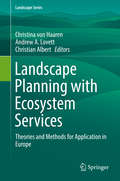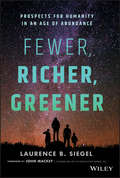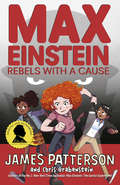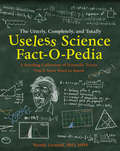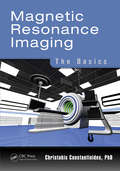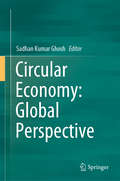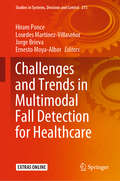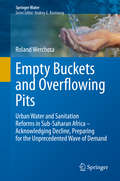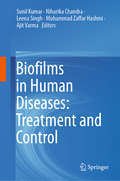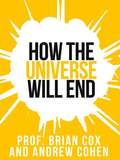- Table View
- List View
Landscape Planning with Ecosystem Services: Theories and Methods for Application in Europe (Landscape Series #24)
by Christina Von Haaren Andrew A. Lovett Christian AlbertHuman well-being depends in many ways on maintaining the stock of natural resources which deliver the services from which human’s benefit. However, these resources and flows of services are increasingly threatened by unsustainable and competing land uses. Particular threats exist to those public goods whose values are not well-represented in markets or whose deterioration will only affect future generations. As market forces alone are not sufficient, effective means for local and regional planning are needed in order to safeguard scarce natural resources, coordinate land uses and create sustainable landscape structures. This book argues that a solution to such challenges in Europe can be found by merging the landscape planning tradition with ecosystem services concepts. Landscape planning has strengths in recognition of public benefits and implementation mechanisms, while the ecosystem services approach makes the connection between the status of natural assets and human well-being more explicit. It can also provide an economic perspective, focused on individual preferences and benefits, which helps validate the acceptability of environmental planning goals. Thus linking landscape planning and ecosystem services provides a two-way benefit, creating a usable science to meet the needs of local and regional decision making. The book is structured around the Driving forces-Pressures-States-Impacts-Responses framework, providing an introduction to relevant concepts, methodologies and techniques. It presents a new, ecosystem services-informed, approach to landscape planning that constitutes both a framework and toolbox for students and practitioners to address the environmental and landscape challenges of 21st century Europe.
Fewer, Richer, Greener: Prospects for Humanity in an Age of Abundance
by Laurence B. SiegelHow the world has become much better and why optimism is abundantly justified Why do so many people fear the future? Is their concern justified, or can we look forward to greater wealth and continued improvement in the way we live? Our world seems to be experiencing stagnant economic growth, climatic deterioration, dwindling natural resources, and an unsustainable level of population growth. The world is doomed, they argue, and there are just too many problems to overcome. But is this really the case? In Fewer, Richer, Greener, author Laurence B. Siegel reveals that the world has improved—and will continue to improve—in almost every dimension imaginable. This practical yet lighthearted book makes a convincing case for having gratitude for today’s world and optimism about the bountiful world of tomorrow. Life has actually improved tremendously. We live in the safest, most prosperous time in all human history. Whatever the metric—food, health, longevity, education, conflict—it is demonstrably true that right now is the best time to be alive. The recent, dramatic slowing in global population growth continues to spread prosperity from the developed to the developing world. Technology is helping billions of people rise above levels of mere subsistence. This technology of prosperity is cumulative and rapidly improving: we use it to solve problems in ways that would have be unimaginable only a few decades ago. An optimistic antidote for pessimism and fear, this book: Helps to restore and reinforce our faith in the future Documents and explains how global changes impact our present and influence our future Discusses the costs and unforeseen consequences of some of the changes occurring in the modern world Offers engaging narrative, accurate data and research, and an in-depth look at the best books on the topic by leading thinkers Traces the history of economic progress and explores its consequences for human life around the world Fewer, Richer, Greener: Prospects for Humanity in an Age of Abundance is a must-read for anyone who wishes to regain hope for the present and wants to build a better future.
Non-coding RNAs in the Vasculature (Cardiac and Vascular Biology #2)
by Thomas Thum Stefanie DimmelerThis book focuses on the importance of regulatory RNAs in the vasculature. The main topics discussed include the role of regRNAs in vascular development and angiogenesis, ischemic cardiovascular disease and repair mechanisms, diabetic and metabolic vascular disease, atherosclerosis and vascular inflammation, as well as diagnostics of vascular disease using circulating miRNAs. Lastly, it offers an overview of emerging topics such as microvesicle-mediated miRNA cellular trafficking and the vascular importance of long non-coding RNAs. It is an invaluable resource for academics, researchers and students working in the field of vascular biology.
The Brain at Risk: Associations between Disease and Cognition
by Erin D. Bigler Dawson Hedges Thomas J. Farrer Ramona O. HopkinsThis important book describes the effects of a range of medical, psychological, and neurological conditions on brain functioning, specifically cognition. After a brief introduction of brain anatomy and function focusing on neural systems and their complex role in cognition, this book covers common disorders across several medical specialties, as well as injuries that can damage a variety of neural networks. The authors review findings on associations between these conditions and cognitive domains such as executive function, memory, attention, and learning, and describe possible causal pathways between diseases and cognitive impairment. Later chapters describe potential strategies for prevention, improvement, and treatment. The book’s topics includeCognition in affective disordersCerebrovascular disease and cognitionCognitive sequelae of sepsisTraumatic brain injury and cognitionCognitive deficits associated with drug useObstructive sleep apnea and cognitionCognitive function in pulmonary diseaseThe Brain at Risk reflects the current interest in the links between body, mind, and brain, and will be of great value to researchers and practitioners interested in neuroscience, neuropsychology, and clinical research in the cognitive and behavioral consequences of brain injury and disease.
Max Einstein: Rebels With A Cause (Max Einstein Series #2)
by James PattersonMax Einstein's typical day is not your average 12-year-old's. She...- TEACHES classes at a New York college- Dodges KIDNAPPING attempts with her best friends- Goes on SECRET MISSIONS for her billionaire boss- Has a MYSTERIOUS CONNECTION to Albert EinsteinJust a day in the life of the Change Makers Institute's top agent!A village outside Mumbai is having a water crisis that only a group of kid geniuses can fix – so Max and her friends travel to India. But it's hard to save the world when you're trying not to be kidnapped by a greedy corporation that profits when others suffer – and seems to know your every move. It's almost like the bad guys have a spy inside the Change Makers...
The Utterly, Completely, and Totally Useless Science Fact-o-pedia: A Startling Collection Of Scientific Trivia You'll Never Need To Know
by Wendy Leonard, PhD MPHCalling all trivia buffs! Loaded with over 200 entries and almost 2,000 bits of trivia, this book will arm you with hundreds of useless scientific tidbits – perfect for curious minds.
Grossopedia: A Startling Collection Of Repulsive Trivia You Won’t Want To Know!
by Rachel FedermanGRUESOME, DISGUSTING, AND ABSOLUTELY VILE! Loaded with hundreds of disgusting, repulsive, gruesome, and loathsome facts, this is by far the foulest collection of trivia around.
Human Respiratory Viral Infections
by Sunit K. SingUsing a multidisciplinary approach, Human Respiratory Viral Infections is set at the level between the definitive reference work and an essential clinical manual. Exploring recent advances in human respiratory viral research, the text builds on the basic sciences of epidemiology, virology, molecular biology, and immunology to cover clinical diagnos
Cancer-Causing Viruses and Their Inhibitors
by Satya Prakash GuptaCancer-causing viruses, also called oncoviruses, play a key role in the development of certain cancers. They contribute to genetic changes that disrupt the cell cycle machinery, interfering with functions such as cell growth. Cancer-Causing Viruses and Their Inhibitors presents a plethora of research from internationally reputed contributors who di
Magnetic Resonance Imaging: The Basics (Latest Advances In Clinical And Pre-clinical Cardiovascular Magnetic Resonance Imaging Ser.)
by Christakis ConstantinidesMagnetic resonance imaging (MRI) is a rapidly developing field in basic applied science and clinical practice. Research efforts in this area have already been recognized with five Nobel prizes awarded to seven Nobel laureates in the past 70 years. Based on courses taught at The Johns Hopkins University, Magnetic Resonance Imaging: The Basics provid
Circular Economy: Global Perspective
by Sadhan Kumar GhoshA circular economy is an alternative to a traditional linear economy (make, use, dispose) in which we keep resources in use for as long as possible, extract the maximum value from them whilst in use, then recover and regenerate products and materials at the end of each service life. Circular economy (CE) is important towards sustainable development, resources circulation and conservation, involving closing of material loops and cascading used resources, to prevent waste occurrence, and transforming the resulting residual streams into new (secondary) resources. Strategies and legislative framework for waste management are important steps for development of a more CE where resource efficiency becomes the key driver for both economic growth and environmental protections. A few countries achieved good results implementing CE as a replacement of the linear economy. Resource managers and planners should thoroughly identify factors to implement CE for societal benefits. This book presents how resource consumption is minimized with rational use based on 3Rs, legislative framework and government supports towards implementing CE initiatives, example of best practices, future plans and targets in different countries those are helpful for researchers, planners and implementers.
Dams and Appurtenant Hydraulic Structures, 2nd edition
by Ljubomir TanchevDams and Appurtenant Hydraulic Structures, now in its second edition, provides a comprehensive and complete overview of all kinds of dams and appurtenant hydraulic structures throughout the world.The reader is guided through different aspects of dams and appurtenant hydraulic structures in 35 chapters, which are subdivided in five themes:I. Dams an
Skin Aging & Cancer: Ambient UV-R Exposure
by Ashish Dwivedi Neeraj Agarwal Lipika Ray Amit Kumar TripathiThis book summarizes the potent effect of ultraviolet radiation (UVR) on the photoaging and cancer formation. Skin is the largest human organ which continually reconstructs itself to ensure its viability, integrity, and ability to provide protection for the body. This protection can be compromised by the aging of the skin which ultimately promotes skin inflammation, impaired wound repair, and increased risk of skin cancer. The book entails mechanistic insights into the UVR-induced immunomodulation and DNA damage in the skin to delineate the pathogenesis, and develop novel ways for prevention of photoaging of the skin cells. It also elucidates the potential of nanotechnology in the treatment of skin cancer. Further, it discusses the bioinformatics approaches to understand the molecular mechanism of photoaging and cancer formation.
Introduction To Quantum Field Theory (PDF)
by Horatiu NastaseQuantum Field Theory provides a theoretical framework for understanding fields and the particles associated with them, and is the basis of particle physics and condensed matter research. This graduate level textbook provides a comprehensive introduction to quantum field theory, giving equal emphasis to operator and path integral formalisms. It covers modern research such as helicity spinors, BCFW construction and generalized unitarity cuts; as well as treating advanced topics including BRST quantization, loop equations, and finite temperature field theory. Various quantum fields are described, including scalar and fermionic fields, Abelian vector fields and Quantum ElectroDynamics (QED), and finally non-Abelian vector fields and Quantum ChromoDynamics (QCD). Applications to scattering cross sections in QED and QCD are also described. Each chapter ends with exercises and an important concepts section, allowing students to identify the key aspects of the chapter and test their understanding.
Challenges and Trends in Multimodal Fall Detection for Healthcare (Studies in Systems, Decision and Control #273)
by Hiram Ponce Lourdes Martínez-Villaseñor Jorge Brieva Ernesto Moya-AlborThis book focuses on novel implementations of sensor technologies, artificial intelligence, machine learning, computer vision and statistics for automated, human fall recognition systems and related topics using data fusion.It includes theory and coding implementations to help readers quickly grasp the concepts and to highlight the applicability of this technology. For convenience, it is divided into two parts. The first part reviews the state of the art in human fall and activity recognition systems, while the second part describes a public dataset especially curated for multimodal fall detection. It also gathers contributions demonstrating the use of this dataset and showing examples. This book is useful for anyone who is interested in fall detection systems, as well as for those interested in solving challenging, signal recognition, vision and machine learning problems. Potential applications include health care, robotics, sports, human–machine interaction, among others.
Freedom and Evolution: Hierarchy in Nature, Society and Science
by Adrian BejanThe book begins with familiar designs found all around and inside us (such as the ‘trees’ of river basins, human lungs, blood and city traffic). It then shows how all flow systems are driven by power from natural engines everywhere, and how they are endlessly shaped because of freedom. Finally, Professor Bejan explains how people, like everything else that moves on earth, are driven by power derived from our “engines” that consume fuel and food, and that our movement dissipates the power completely and changes constantly for greater access, economies of scale, efficiency, innovation and life. Written for wide audiences of all ages, including readers interested in science, patterns in nature, similarity and non-uniformity, history and the future, and those just interested in having fun with ideas, the book shows how many “design change” concepts acquire a solid scientific footing and how they exist with the evolution of nature, society, technology and science.
Empty Buckets and Overflowing Pits: Urban Water and Sanitation Reforms in Sub-Saharan Africa – Acknowledging Decline, Preparing for the Unprecedented Wave of Demand (Springer Water)
by Roland WerchotaThis book provides a multi-level and multi-dimensional insight into urban water and sanitation development by analyzing sector reforms in Africa. With the recent events in mind - water shortages in Cape Town, widespread cholera in Haiti, mass-migration from low-income countries, etc. – it elaborates a pressing topic which is directly linked to the precarious living conditions of the urban poor in the developing countries. It is urgent to acknowledge the proposed findings and recommendations of the book which will help to improve the situation of potential refugees in their home countries with a realistic vision for the development of the most basic of all life supporting services.So many efforts to reverse the negative trend in water and sanitation development have failed or targets have been repeatedly missed by far without notable consequences for decision makers on different levels and institutions. It has unnecessarily consumed many young lives, contributed to keep billions in poverty until today and fostered discrimination of women. The knowledge gap and the confusion in the sector lined out in the book becomes evident when a national leader in a low-income country declares a state of emergency in urban water and sanitation while at the same time global monitoring publishes an access figure for urban water of over 90% for the same country. It is time to change this with an effective sector development concept for our partner countries and a more realistic discourse on global level.The book argues for a sweeping rethinking and combines extended local knowledge, lessons learned from history in advanced countries and thorough research on reforms in Francophone and Anglophone developing countries. This was possible because the writer was working in Sub-Saharan partner countries for almost 30 years as an integrated long term advisor in different sector institutions (ministry, regulator, financing basket and different sizes of utilities) and had the opportunity to cooperate closely with the main development partners.The reader has the opportunity to obtain a comprehensive understanding of how the sector works and sector institutions in low-income countries function and can discover the reasons behind success and failures of reforms. The book also covers issues which have a significant influence on urban water and sanitation development but are hardly the subject of discussions. It helps to make the shortcomings of the water and sanitation discourse more apparent and assist institutions to move beyond their present perceptions and agendas. All of this makes the book different from other literature about urban water and sanitation in the developing world.
Biofilms in Human Diseases: Treatment and Control
by Sunil Kumar Niharika Chandra Leena Singh Muhammad Zaffar Hashmi Ajit VarmaThis book highlights treatment strategies for bacterial biofilms in connection with a variety of human diseases. In particular, it reviews bacterial biofilm formation and its mechanism. Topics covered include biofilms in human health, the role of biofilms in mediating human diseases, and methods for testing bacterial biofilms. Further sections concentrate on biofilm-mediated diseases in different parts of the human gastrointestinal tract, while therapeutic strategies for biofilm control and natural agents that disrupt bacterial biofilms are also covered. Readers will also find the latest advances in probiotics and biofilms, as well as the use of probiotics to counteract biofilm-associated infections. Biofilms and antimicrobial resistance are discussed. Subsequent chapters address the management of inflammatory bowel disease via probiotics biofilms, as well as the role of probiotics bacteria in the treatment of human diseases associated with bacterial biofilms. The book is chiefly intended for clinicians/scientists in the fields of medical microbiology, applied microbiology, biochemistry, and biotechnology.
Galactic Astronomy (Princeton Series in Astrophysics #9)
by James Binney Michael MerrifieldThis is the definitive treatment of the phenomenology of galaxies--a clear and comprehensive volume that takes full account of the extraordinary recent advances in the field. The book supersedes the classic text Galactic Astronomy that James Binney wrote with Dimitri Mihalas, and complements Galactic Dynamics by Binney and Scott Tremaine. It will be invaluable to researchers and is accessible to any student who has a background in undergraduate physics. The book draws on observations both of our own galaxy, the Milky Way, and of external galaxies. The two sources are complementary, since the former tends to be highly detailed but difficult to interpret, while the latter is typically poorer in quality but conceptually simpler to understand. Binney and Merrifield introduce all astronomical concepts necessary to understand the properties of galaxies, including coordinate systems, magnitudes and colors, the phenomenology of stars, the theory of stellar and chemical evolution, and the measurement of astronomical distances. The book's core covers the phenomenology of external galaxies, star clusters in the Milky Way, the interstellar media of external galaxies, gas in the Milky Way, the structure and kinematics of the stellar components of the Milky Way, and the kinematics of external galaxies. Throughout, the book emphasizes the observational basis for current understanding of galactic astronomy, with references to the original literature. Offering both new information and a comprehensive view of its subject, it will be an indispensable source for professionals, as well as for graduate students and advanced undergraduates.
Principles of Virology, Volume 2: Pathogenesis and Control (ASM Books)
by S. Jane Flint Vincent R. Racaniello Glenn F. Rall Anna Marie SkalkaPrinciples of Virology Fourth Edition Principles of Virology is the leading virology textbook because it does more than collect and present facts about individual viruses. Instead, it facilitates an understanding of basic virology by examining the shared processes and capabilities of viruses. Using a set of representative viruses to present the complexity and diversity of a myriad of viruses, this rational approach enables students to understand how reproduction is accomplished by known viruses and provides the tools for future encounters with new or understudied viruses. This fully updated edition represents the rapidly changing field of virology. A major new feature is the inclusion of 26 video interviews with leading scientists who have made significant contributions to the field of virology. Applicable courses: undergraduate courses in virology and microbiology as well as graduate courses in virology and infectious diseases.
Electroanalytical Chemistry: Principles, Best Practices, and Case Studies (Chemical Analysis: A Series of Monographs on Analytical Chemistry and Its Applications)
by Gary A. MabbottProvides a strong foundation in electrochemical principles and best practices Written for undergraduate majors in chemistry and chemical engineering, this book teaches the basic principles of electroanalytical chemistry and illustrates best practices through the use of case studies of organic reactions and catalysis using voltammetric methods and of the measurement of clinical and environmental analytes by potentiometric techniques. It provides insight beyond the field of analysis as students address problems arising in many areas of science and technology. The book also emphasizes electrochemical phenomena and conceptual models to help readers understand the influence of experimental conditions and the interpretation of results for common potentiometric and voltammetric methods. Electroanalytical Chemistry: Principles, Best Practices, and Case Studies begins by introducing some basic concepts in electrical phenomena. It then moves on to a chapter that examines the potentiometry of oxidation-reduction processes, followed by another on the potentiometry of ion selective electrodes. Other sections look at: applications of ion selective electrodes; controlled potential methods; case studies in controlled potential methods; and instrumentation. The book also features several appendixes covering: Ionic Strength, Activity and Activity Coefficients; The Nicolsky-Eisenman Equation; The Henderson Equation for Liquid Junction Potentials; Selected Standard Electrode Potentials; and The Nernst Equation Derivation. Introduces the principles of modern electrochemical sensors and instrumental chemical analysis using potentiometric and voltammetric methods Develops conceptual models underlying electrochemical phenomena and useful equations Illustrates best practice with short case studies of organic reaction mechanisms using voltammetry and quantitative analysis with ion selective electrodes Offers instructors the opportunity to select focus areas and tailor the book to their course by providing a collection of shorter texts, each dedicated to a single field Intended as one of a series of modules for teaching undergraduate courses in instrumental chemical analysis Electroanalytical Chemistry: Principles, Best Practices, and Case Studies is an ideal textbook for undergraduate majors in chemistry and chemical engineering taking instrumental analysis courses. It would also benefit professional chemists who need an introduction to potentiometry or voltammetry.
Heat Stress Tolerance in Plants: Physiological, Molecular and Genetic Perspectives
by Shabir HussainWaniDemystifies the genetic, biochemical, physiological, and molecular mechanisms underlying heat stress tolerance in plants Heat stress—when high temperatures cause irreversible damage to plant function or development—severely impairs the growth and yield of agriculturally important crops. As the global population mounts and temperatures continue to rise, it is crucial to understand the biochemical, physiological, and molecular mechanisms of thermotolerance to develop ‘climate-smart’ crops. Heat Stress Tolerance in Plants provides a holistic, cross-disciplinary survey of the latest science in this important field. Presenting contributions from an international team of plant scientists and researchers, this text examines heat stress, its impact on crop plants, and various mechanisms to modulate tolerance levels. Topics include recent advances in molecular genetic approaches to increasing heat tolerance, the potential role of biochemical and molecular markers in screening germplasm for thermotolerance, and the use of next-generation sequencing to unravel the novel genes associated with defense and metabolite pathways. This insightful book: Places contemporary research on heat stress in plants within the context of global climate change and population growth Includes diverse analyses from physiological, biochemical, molecular, and genetic perspectives Explores various approaches to increasing heat tolerance in crops of high commercial value, such as cotton Discusses the applications of plant genomics in the development of thermotolerant ‘designer crops’ An important contribution to the field, Heat Stress Tolerance in Plants is an invaluable resource for scientists, academics, students, and researchers working in fields of pulse crop biochemistry, physiology, genetics, breeding, and biotechnology.
Structural Biology in Drug Discovery: Methods, Techniques, and Practices
by Jean-Paul RenaudWith the most comprehensive and up-to-date overview of structure-based drug discovery covering both experimental and computational approaches, Structural Biology in Drug Discovery: Methods, Techniques, and Practices describes principles, methods, applications, and emerging paradigms of structural biology as a tool for more efficient drug development. Coverage includes successful examples, academic and industry insights, novel concepts, and advances in a rapidly evolving field.The combined chapters, by authors writing from the frontlines of structural biology and drug discovery, give readers a valuable reference and resource that: Presents the benefits, limitations, and potentiality of major techniques in the field such as X-ray crystallography, NMR, neutron crystallography, cryo-EM, mass spectrometry and other biophysical techniques, and computational structural biology Includes detailed chapters on druggability, allostery, complementary use of thermodynamic and kinetic information, and powerful approaches such as structural chemogenomics and fragment-based drug design Emphasizes the need for the in-depth biophysical characterization of protein targets as well as of therapeutic proteins, and for a thorough quality assessment of experimental structures Illustrates advances in the field of established therapeutic targets like kinases, serine proteinases, GPCRs, and epigenetic proteins, and of more challenging ones like protein-protein interactions and intrinsically disordered proteins
Welcome to the Genome: A User's Guide to the Genetic Past, Present, and Future
by Robert DeSalle Michael YudellThe popular introduction to the genomic revolution for non-scientists—the revised and updated new edition Welcome to the Genome is an accessible, up-to-date introduction to genomics—the interdisciplinary field of biology focused on the structure, function, evolution, mapping, and editing of an organism's complete set of DNA. Written for non-experts, this user-friendly book explains how genomes are sequenced and explores the discoveries and challenges of this revolutionary technology. Genomics is a mixture of many fields, including not only biology, engineering, computer science, and mathematics, but also social sciences and humanities. This unique guide addresses both the science of genomics and the ethical, moral, and social questions that rise from the technology. There have been many exciting developments in genomics since this book's first publication. Accordingly, the second edition of Welcome to the Genome offers substantial new and updated content to reflect recent major advances in genome-level sequencing and analysis, and demonstrates the vast increase in biological knowledge over the past decade. New sections cover next-generation technologies such as Illumina and PacBio sequencing, while expanded chapters discuss controversial ethical and philosophical issues raised by genomic technology, such as direct-to-consumer genetic testing. An essential resource for understanding the still-evolving genomic revolution, this book: Introduces non-scientists to basic molecular principles and illustrates how they are shaping the genomic revolution in medicine, biology, and conservation biology Explores a wide range of topics within the field such as genetic diversity, genome structure, genetic cloning, forensic genetics, and more Includes full-color illustrations and topical examples Presents material in an accessible, user-friendly style, requiring no expertise in genomics Discusses past discoveries, current research, and future possibilities in the field Sponsored by the American Museum of Natural History, Welcome to the Genome: A User's Guide to the Genetic Past, Present, and Future is a must-read book for anyone interested in the scientific foundation for understanding the development and evolutionary heritage of all life.
Prof. Brian Cox’s How The Universe Will End (Collins Shorts #1)
by Professor Brian CoxCollins Shorts – insight in an instant.
